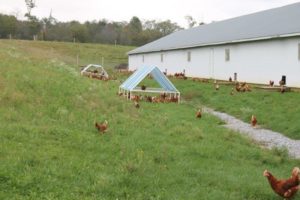Pete and Gerry’s Organic Eggs

| Rating |     |
| Farm/Brand Headquarters | Monroe, NH |
| Website | https://www.peteandgerrys.com/ |
| Market Area | East Coast |
| Total Score | 1100 |
Pete and Gerry’s is an example of a large-scale producer that is moving away from the industrial model of egg production, committed instead to increasing both indoor and outdoor access for its birds. At its New Hampshire location, the company has attached winter gardens (like a screened-in porch for chickens) to all its organic buildings, and increased vegetated outdoor space as well.
They write: “Pete and Gerry’s Organic Eggs is a family owned and operated farm and processor of organic eggs, located in Northern New Hampshire, near the White Mountain National Forest. Pete and Gerry’s was the first egg farm in the country to be recognized by Humane Farm Animal Care’s Certified Humane program. Along with producing eggs at the family farm in Monroe, NH, Pete and Gerry’s has been able to grow by partnering with nearly 20 other family farms throughout the Northeast. Pete and Gerry’s is also actively pursuing and supporting new partnerships with local New England based farmers who would like to produce eggs with us.”
| Criteria | Points | Comment |
|---|---|---|
| TOTAL (possible score is 1700) | 1100 | 4-egg     |
|
Brands that have close daily control over their egg production receive the most points. Ownership Structure | 75 | Multiple farms supply this brand, which is family owned and operated, with a close relationship |
|
Brands that only produce organic products make the biggest investments — in time and money — in systems that benefit us all. Eggs sourced from a single operation receive the most points. Eggs of unclear origins and/or with poor oversight receives the fewest points. Commitment to Organic Label | 100 | Brand only sells organic eggs |
|
Additional certifications, depending on the credibility of the label, can demonstrate a commitment beyond the organic standards. Other Labels and Standards | 50 | Certified Humane (free range standards); Certified B Corp |
|
Smaller flock sizes (the number of laying hens per housing structure) offer better animal welfare conditions. Flock Size(s) | 50 | The majority of suppliers have flock sizes less than 20,000 birds |
|
The best housing offers space for natural behaviors and legitimate access to the outdoors through adequate exits. Hen Housing and Exit Areas | 60 | Fixed housing barns; popholes that are big enough to encourage hens exiting (but only 1-2 sides of the barn) |
|
Adequate indoor spacing reduces stress and disease. With less crowding, birds can stretch their wings and more easily perform other natural behaviors. Indoor Spacing | 20 | 1.2 square feet allotted per hen |
|
High scoring brands provide enough space to allow each hen to fully utilize their outdoor area, and to perform instinctive behaviors without harming the environment. Outdoor Spacing | 20 | 2 square feet brand standard per hen |
|
High quality outdoor access includes vegetation, soil, and ample opportunities to forage year-round. Quality of Outdoor Access | 40 | Outdoor area is not rotated; no brand standard though most retain 50% vegetation |
|
Birds that are introduced to the outdoors early are more accustomed to spending time outdoors without fear or stress. Outdoor Access Timing | 80 | Typical age is 16 weeks |
|
Year-round access to perches, scratching areas, deep litter, novel foodstuffs, and dust bathing contribute to quality of life. Enrichments | 90 | Enrichments provided indoors and outdoors |
|
Chickens use their beaks to interact with the world. Authentic organic farmers account for this behavior, eschewing beak trimming. Alterations | 70 | Hens are beak trimmed at hatchery; induced molting is not allowed |
|
Raising chicks on farm or buying them from certified organic hatcheries shows dedication to organic production from start to finish. Chicks and Pullets | 50 | Suppliers purchase chicks and ready to lay pullets from hatcheries |
|
Brands that have low rates of deaths and utilize their spent hens for human consumption or similar score the highest. Deaths, Culls, and Spent Hens | 100 | Death rate below 2%; spent hens are sold live for food |
|
Brands that closely monitor and manage health of soil, native species, and water quality receive the most points. Environmental Impacts | 70 | Brand uses Certified Humane standards to dictate pasture/outdoor care |
| Feed Sourcing | 75 | Brand dictates the type of feed its suppliers use; commercial mixes |
|
Brands that score well here go above and beyond to ensure the highest animal welfare, taking into consideration their hens’ safety and cleanliness, natural behavior, and stress levels. Animal Welfare | 50 | Good basic animal welfare benchmark met |
|
Cornucopia believes you have a right to transparency. Top brands share information with Cornucopia via a survey and cooperate with our own independent investigations. Transparency | 100 | Full and open transparency |
|
Brands do not receive points, but this information is offered for people with soy and/or gluten allergies. Soy free and/or gluten free? | Layers are fed gluten and soy | |
|
Brands do not receive points, but are invited to submit the name of their Accredited Organic Certifier (suppliers may have different certifiers). Organic Certifier (non-scoring) | QCS (Quality Certification Services) and OnMark Certification Services | |
|
Extra credit is offered for various practices that go above-and-beyond in some form. Extra Credit | 0 | None |

